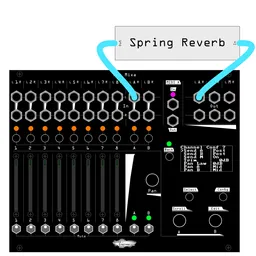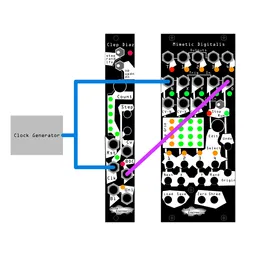Long before I came to the world of Eurorack, I was fascinated with chiptune, a genre of music inspired by and created on oldschool video game consoles. I spent countless hours playing with LSDJ on an old GameBoy I had found. This spawned my everlasting love for trackers, but also showed me a world where entire songs had to be created with two PWM voices, some absolutely terrible samples, and noise bursts. Because of these relatively extreme limitations, workarounds were devised by early soundtrack programmers that gave game soundtracks and contemporary music in the genre a very distinctive sound. One of these workarounds is the way that chords are (sort of) played: with only two voices it doesn’t make sense to actually play a chord most of the time, so extremely fast arpeggios would be played on one voice instead. This sound is something you’ve almost certainly heard even if you’ve never listened to modern chiptune as it was all over the place in game soundtracks for quite some time.
Today, we’ll look at a way to emulate this sound with a few NE modules.
The concept
The arpeggios that are played in chiptune tracks are incredibly fast, almost audio rate. This gives them their distinctive sound and also helps create the illusion that more than one note is being played at a time.
The way that we’ll create this effect actually takes quite a few modules, but the result is pretty unique and sounds really fun.
First, let’s create the arpeggio: Grab a Vox Digitalis (or any other sequencer that can be clocked really fast), set its sequence length to 3, and program in a simple triad arpeggio. Patch an LFO or high-speed clock to the beat input Vox Digitalis, and patch the output of VD to the 1v/8va input of a PWM oscillator. Turn up the LFO’s frequency until it’s as fast as sounds good to your ears and you’re off! Instant chiptune arpeggios. Play with the pulse width to really dial in that oldschool sound: in my experience, thinner pulses are better.
But wait, that’s just one arpeggio…
Learn more:
Transposition
What if we want to actually play a simple chord line with this arpeggio? Easy enough. Did you read our post on vibrato? We’ll use a similar concept here: patch the output of Vox Digitalis into Quantus Pax, patch another sequence into a second input on QP, and now you can transpose your arpeggio! This lets us make entire sequences out of that arpeggiated chord. Here’s how that patch would look:

Now, obviously, there’s nothing controlling the dynamics of our oscillator, so we’ll probably want to run our oscillator through a VCA controlled by an envelope. Personally, I like to use simple ASR envelopes with fast attack and release values, as it sounds most chiptune-y to me. So what’s this sound like, you may ask? Let’s find out! Here, I’ve used the structure above to create an arpeggio. I’m using two PWM oscillators, a white-noise oscillator, and a couple of samples through a bit crusher from the Erica Synths Sample Drum to create a fully voiced patch.
What else can we use this for?
Obviously, there are things we can do with this outside of chiptune sounds. These types of techniques are why I love precision adders so much: we can combine multiple CV sources that aren’t very complicated and make them do really interesting things together. A slow arpeggio getting transposed around can sound beautiful when controlling the right voice, and by slowing the LFO that we used in this example down you can turn your funky chiptune into some lush, evolving melodies.
If you make a cool patch with this technique, tag us on Instagram so everyone can see!






